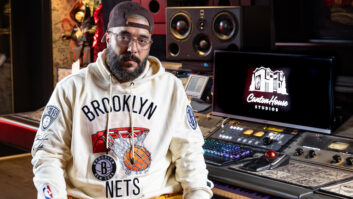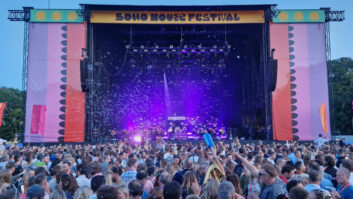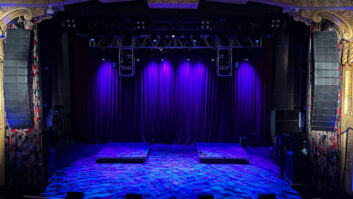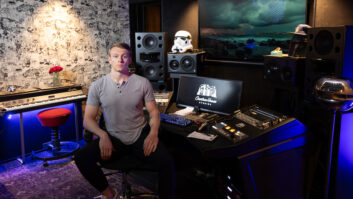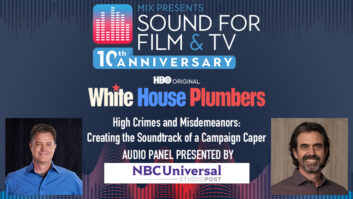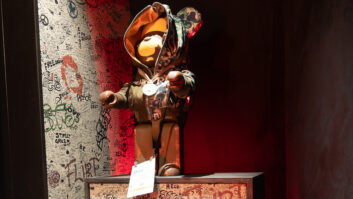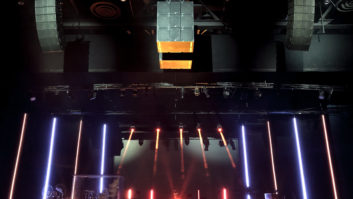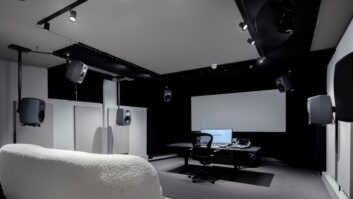ALTADENA, CA—How do you get some of the best drum sounds on the West Coast? For Rich Mouser, it started with a lucky discovery.
About 15 years ago, Mouser got word that the owner of the building in which he was renting space was about to will it to the University of Southern California. After a fruitless search, he and his wife found a house for sale on a quiet dead-end street in nearby Altadena. Mouser walked into the living room, with its 35-foot cathedral ceiling, clapped his hands, and knew that he’d found the perfect spot for The Mouse House Studio.
After turning an entire home into his Mouse House recording studio, Rich Mouser found its centerpiece: A 56-input Calrec UA8000 console, which he bought used for $28,000. The building was rundown and needed a lot of work. “First, I had to turn it back into a house, just to pass inspection,” says Mouser. That done, he set about converting it into a recording studio. “I went to crazy lengths to soundproof. There are double walls everywhere, and there’s really excellent separation between the live room and control room.”

He initially intended to install his existing mixing console alongside an extensive collection of vintage gear amassed over the past 25 years, including classic pieces from Deltalab, EMT, Lexicon, Neve, Telefunken, Valley People and Urei. “Then my friend Peter Reardon [Shadow Hills Industries founder] called and said he’d seen a board for sale in the Recycler.”
The 56-input, 32-buss Calrec UA8000 analog desk was too good to pass up. “I got it for $28,000. I found the bill of sale—in 1987, they paid $288,000 for it. I had to dump about $10,000 into getting it going, and I’ve recently recapped it. I really dig the way it sounds. It reminds me of a cross between an API and a Neve, very musical. There were only 13 made. ABBA had one, and there was one at Abbey Road.”
For a long time, the Calrec was paired with Mouser’s MCI JH-24 two-inch 24-track, Tascam ATR-60 one-inch 16-track and Ampex ATR-102 half-inch stereo analog tape machines. “I was late in the game to Pro Tools,” he confesses. “I fought it until I got called to do a mix for Weezer. I called around to rent a room with Pro Tools. It was going to eat up 75 percent of my budget, so I bought a Pro Tools rig.”
He continues to use whichever format suits the project. “When you’re tracking drums in Pro Tools, the levels are all set nice and then the snare drum pops into the red. You go to tape and none of that happens, and the high-end gets all smoothed out,” he says.
Ideally suited to tracking drums, the 18-foot x 27-foot x 33-foot recording space enables Mouser to conjure up Bonham-esque or Hugh Padgham-like sounds. “I’ve taken so much from Padgham’s playbook,” he says.
He starts with room mics. “I’ll have little Shure 545s pointing at the walls, or pointing up at the ceiling, with an old U 48 Neumann. Then I’ll sneak in some close mics, and put an [EV] RE-20 on the beater side of the kick. I’ll take the room mics and gate them, keying them off the close mics. I can get some really crazy stuff. It’s fun.”
For tight drum sounds, there is a smaller room that also houses a large collection of classic guitar amps. Beyond that is a small iso room for vocals or instruments. The facility also includes a large lounge and kitchen, while the upstairs rooms offer accommodation for anyone visiting for extended periods.
There are no main monitors at Mouse House, just a pair of Tannoy PBM-6.5 nearfields with a sub. “I’ve had them for a long time. I just got used to them, and I’ve learned to mix so that it translates. I have more of them, so when I do a 5.1 project, I just pop a couple more out here.”
As an engineer, producer and mixer, Mouser is constantly bouncing between projects. He has developed a hybrid workflow, essentially zeroing-out the console and his outboard processers and relying on his 48-channel Pro Tools|HDX system to recall sessions, set up headphone mixes, and drive the aux sends and effects inserts.
“I get my general sound on the board, then tweak it in Pro Tools; everything pretty much recalls deadon,” he reports.
Mouser, who grew up listening to groups such as Yes, is known for his work with prog rock bands. He’s worked on every album to date with Spock’s Beard as well as its members’ many related bands. The latest album by offshoot super-group Transatlantic won Album of the Year at the third-annual Progressive Music Awards in England. He also works in other genres, including jazz, country and mainstream rock, with clients including Robert Trujillo, Chris Cornell, Chris Vrenna/Tweaker, Corrosion of Conformity, Stanley Clarke and Hubert Laws.
Mouser has been playing guitar and recording since his teens, and recently came out from behind the board to take the stage with postgrunge band Oleander, opening for Three Doors Down and Chris Daughtry. He’s been working with the band since 1997, and in 2013 was invited to join full-time. “I enjoy getting out,” he says. “I want to play more.”
The Mouse House Studio
themousehousestudio.com
